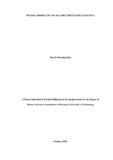Spatial Modelling of Malaria Prevalence in Kenya
Abstract
Malaria is a leading cause of deaths in Kenya. A vector-borne disease caused by parasite of genus plasmodium; the disease is introduced into the human circulatory system from bites caused by infected female anopheles’ mosquitoes. A lot of effort and resources has been put in the fight against malaria, with large amount of national budget being used in the fight against malaria in developing countries which has led to underdevelopment, impoverished livelihoods and low human development index. Malaria burden affects the world’s poorest countries. About 90% of the malaria burden is reported in sub-Saharan Africa. Malaria cases are significantly high in countries of south-East Asia, Western Pacific region, Mediterranean and the Americas. As of 2017, five countries India, Uganda, DR Congo and Mozambique accounted for half of malaria cases reported around the world. In Kenya, the disease has led to impoverished livelihoods with the poorest communities of the country being the most affected. The disease has led to high mortality cases in children under five years and pregnant women. Loss of man hours and work days among adults in the country, leading to low productivity. Studies have shown that there has been a general lack of knowledge on how select demographic and social economic conditions risk factors affect the prevalence of malaria in Kenya. The method of the study involved performing the spatial models for malaria prevalence in Kenya while relaxing the assumptions of stationarity. The assumptions of linearity allowed some covariates like age to have a non-linear effect on prevalence of malaria. Using random walk model of 2nd order and the assumption of stationarity, it allowed covariates to vary spatially. Conditional autoregressive model was used. Data from malaria indicator survey of 2015 (KMIS2015) was used for the study. Both the social-economic and demographic variables were used as predictor variables. These included education level, wealth index, age, access to mosquito nets and place of residence. From the study, demographic and social-economic factors were found to have significant impact on Prevalence of malaria in Kenya. Most cases of malaria were reported in lake, western and coastal regions. The most prone areas were Kisumu, Homabay, Kakamega and Mombasa. There were less cases in central Kenya counties like Nyeri, Tharaka-Nithi with a significant number reported in arid and semi-arid regions of Northern-Kenya counties of Garissa, Mandera, Baringo. Rural population was more susceptible to malaria compared to those in urban areas. The odds of getting (verse not getting malaria) in urban places of residence increases by 0.84, which is estimated to .096, CIs 95% (0.70, 1.01), and a p-value .069. Malaria prevalence varied significantly from one region to another. The study established that Spatial autocorrelation exists among regions mostly due to weather patterns, geography, cultural practices and socio-economic factors.

